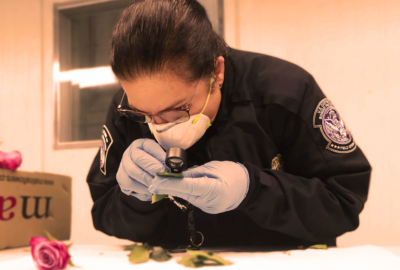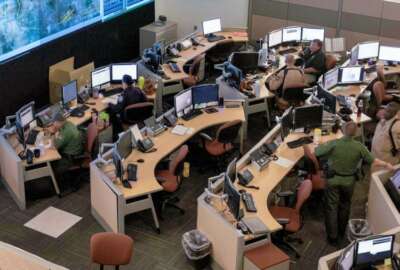

Hubbard Radio Washington DC, LLC. All rights reserved. This website is not intended for users located within the European Economic Area.
Products made with forced labor are banned from the United States. But the law doesn't stop all of them from coming in.
Best listening experience is on Chrome, Firefox or Safari. Subscribe to Federal Drive’s daily audio interviews on Apple Podcasts or PodcastOne.
Products made with forced labor are banned from the United States. But the law doesn’t stop all of them from coming in. It falls to Customs and Border Protection to prevent the flow and to prosecute perpetrators through civil enforcement. But the Government Accountability Office found CBP lacks an important ingredient in this effort. Federal Drive with Tom Temin got details from the GAO’s Director of International Affairs and Trade Issues, Kimberly Gianopoulos.
Interview transcript:
Tom Temin: Ms. Gianopolous, good to have you on.
Kimberly Gianopoulos: Thank you for having me today.
Tom Temin: So you looked at a new office formed in 2018 by CBP to take on companies and those that are bringing in products from forced labor. Give us the background on what CBP is supposed to do precisely.
Kimberly Gianopoulos: Well, CBP is the primary agency responsible for enforcing what’s called Section 307 of the Tariff Act of 1930. And this section prohibits the importation of goods made with forced labor. Now, this requirement was slightly changed by the Trade Facilitation and Trade Enforcement Act, which was passed in 2016. What it did was it took away the consumptive demand clause. Now what does that mean? That means that in the past, the United States could import goods made with forced labor, basically, if the US couldn’t produce those goods on its own to meet the demand of the US economy, but TIFTIA, Trade Facilitation and Trade Enforcement Act, took away that loophole so that no forced labor goods could come in under that section. So CBP was tasked with making the change in its enforcement and its enforcement authority to detain shipments when information indicated that forced labor produced those goods under any circumstances. Associated with that is ICE, where they’re responsible for investigating potential crimes related to forced labor. And those importers could be subject to prosecution.
Tom Temin: Okay, so CBP formed a forced labor division a couple of years ago, and it hasn’t worked out all that well. It doesn’t sound like they have that much money. They’ve got 1.4 million, which doesn’t seem like a lot to stop in this day and age of almost unfettered international trade.
Kimberly Gianopoulos: Right. And forced labor is a significant problem. The International Labor Organization estimates that force labor generates profits of over $150 billion dollars a year globally. So CBP in developing the force labor division, filled some staff positions, but they experienced significant turnover in those positions. What we also found is that they really didn’t determine their workforce needs for this division. They had plans to expand and train the workforce, but they really didn’t assess a number of things, the number, type, locations, or specialized skills of positions that needed to achieve the results that was tasked with achieving. And without doing so, we found that the division lost reasonable assurance that it has the right number of people with the right skills in the right places. So we made a recommendation that they perform and document a needs assessment to identify gaps in the divisions workforce,
Tom Temin: And just backing up a moment, what are the kinds of products that tend to come in this way? And how do they come in? Are they like on eBay or Amazon or something?
Kimberly Gianopoulos: They can come in a variety of ways, because the goods quite frankly, are quite broad. One of the things that CBP can issue is what’s called a withhold release order or a WRO. These withhold release orders will allow CBP agents to detain shipments at the border where there’s a expectation that the goods were produced with forced labor. They can also issue what’s called a finding, which is a higher bar, or they can actually stop them completely from coming in and seize them. So the goods themselves can range quite broadly from textiles, which is something that you hear in the news these days from the wider region of China, to even PPE to fight the COVID-19 pandemic. It’s really a wide range of goods, and it’s a very high bar to try to determine whether or not forced labor is actually producing these goods. And CBP is tasked with making sure that when there’s a reasonable assumption that the forced labor is being used, that the goods just don’t come into the country.
Tom Temin: Sure, they must have some idea of the countries where this is more likely to originate, for example, materials coming from France, it’s probably low probability of forced labor, whereas maybe some of the African nations or certain Asian nations could have that issue.
Kimberly Gianopoulos: Sure, they have a four step investigative process actually to identify items that might be produced under forced labor, and that they would have to stop at the border. The four phases include initiation where they make allegations of forced labor from a variety of different actors, whether they’re NGOs working in the country to State Department officials at the embassies to a wide variety of folks. Then they investigate that information and they look into it to see whether or not there’s evidence to issue a WRO or a finding. And they use a lot of data and on the ground information that they’re able to gather. The third phase is a legal review, where they present their allegation report to the CBP Office of Chief Counsel for legal sufficiency review, that review is evaluated, and if they determined that there’s enough evidence to show that something is reasonably but not conclusively produced with forced labor, they can issue a WRO. Again, the higher bar is for the finding, where if they can determine from the evidence that it conclusively demonstrates the merchandise was produced with forced labor, they can issue a finding. And then finally, the fourth phase is implementation where CBP can approve the recommendation package, issue the WRO or issue the finding and take action to stop the goods from coming into the United States.
Tom Temin: So basically, your finding is they just don’t have sufficient staffing. In fact, you report that several investigations had to be suspended because there was nobody to do them.
Kimberly Gianopoulos: That’s right. They told us that they had to suspend some of their efforts because they had insufficient staff to complete the work. They also told us that as of March 2020, they initiated more than 100 investigations. But we also found that summary data was missing on the sources of evidence for almost all of their active cases, the incomplete and inconsistent summary data on the characteristics, and the status of the cases could hinder the managers effective monitoring of case progress and enforcement efforts. So our second recommendation was that they take steps to improve the completeness, consistency, and accuracy of their summary data on active suspended and inactive forced labor investigations, partially so that they could best use their limited resources to do the most they can with the people they have.
Tom Temin: Sure. And your third recommendation was just to make sure that they snap to and get some arms around this program. I’m paraphrasing. That’s my interpretation of it. But basically, they really gotta get serious about this program.
Kimberly Gianopoulos: Well, it’s it’s hard to determine whether you’re successful if you don’t know what your goals are. And we found that they hadn’t set targets for their key performance indicators to monitor their efforts. So if you haven’t established these targets more than two years after the division was set up, it’s hard to figure out what you’re trying to accomplish. And if you’re halfway there, three quarters of the way there or if you’re not making any progress at all. So we suggested that they set the targets for these indicators related to the enforcement of the prohibition on forced labor imports.
Tom Temin: And what should some of the targets be? Number of investigations completed, tonnage of goods prevented from coming in? I mean, there’s a lot of ways you could skin the cat.
Kimberly Gianopoulos: There certainly are a lot of ways to figure out what success means. And given the restrictions and the difficulties that the forced labor division has had, given its limited resources, we didn’t specify what those targets should be, partially because we don’t know the information as well as CBP does. And we determined that they should figure out what the right targets are for the level of resources that they have so they can figure out how much progress they’re making, if they need to make adjustments to either the number of folks who are working on these issues or the way that they’re approaching the issues, that’s really up to them.
Tom Temin: And do they pretty much go along with the recommendations?
Kimberly Gianopoulos: They agreed with all three of our recommendations. We have not gotten the letter back yet saying exactly how they’re going to implement those recommendations. But in their comments on our report, they said that they were going to implement them and we will check back as we always do, at least once or twice a year to see how much progress they’re making.
Tom Temin: Kimberly Gianopolous is director of International Affairs and Trade issues at the GAO. Thanks so much for joining me.
Kimberly Gianopoulos: Thank you for having me today Tom.
Copyright © 2024 Federal News Network. All rights reserved. This website is not intended for users located within the European Economic Area.
Tom Temin is host of the Federal Drive and has been providing insight on federal technology and management issues for more than 30 years.
Follow @tteminWFED



